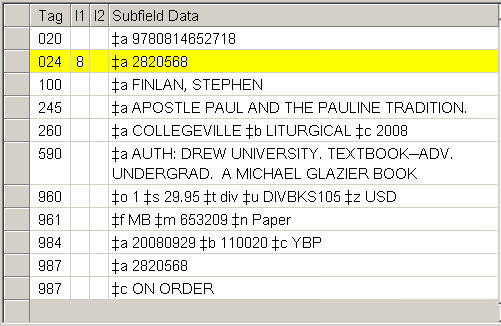Vendor On-Order Records to be Overlaid
To: Technical ServicesStaff
From: Steven Arakawa
Date: (10/28/08 issue date/ 01/12/2012 9:01 AM revision date)
Staff should be aware that Orbis now includes on-order vendor records that will be overlaid via batch-processing after the book is received. Locations represented by these records now include: SML, science libraries, Divinity Library, Arts Library, and the Social Science Library. The current vendors providing this service are YBP and Lindsey & Croft. These records will have the following characteristics:
- Most of the bib record will be in CAPS
- The operator code under the History tab will begin with Y or L followed by F or S
- The encoding level in the Leader will be z
- An item record will be attached to the MFHD but the item record will not have a barcode number
- The record will be associated with an Orbis acquisitions order record
- The record will display in the OPAC
These records will be batch-overlaid based on the 024 match point generally no later than 2 weeks after receipt of the book. Please notify Lynette Robinson in SML Acquisitions if the overlay has not taken place within this time frame.
The vendor bibliographic (cataloged) record that will eventually overlay the vendor On-Order record will either be
- cataloging copy from LC (full, core, or CIP upgraded by the vendor)
- OCLC member copy at an adequate Encoding Level or,
- a vendor created bibliographic record with one subject (the Encoding Level will remain z for the vendor created record)
The vendor is contracted to supply a 090 with the bibliographic (cataloged) record. In some cases, the vendor will provide a preassigned call number label derived from the 090
Those staff with cataloging authorization should generally avoid updating the On-Order records, for the following reasons:
- we have already paid the vendor to provide a catalog record to replace the On-Order record
- if the cataloger forgets to remove the 024 match point, all changes to the updated record will be wiped out by the vendor provided cataloging record after the item is received
In addition, if the vendor supplies a call number label with the book,
- updating the record prior to the overlay will require the acquisitons staff to key in the call number from the label rather than use the more accurate CTRL-N function
- if the Yale cataloger creates the catalog record and provides a 050/090, and receipt staff use the CTRL-N function in error, it is likely there will be a discrepancy between the number copied into the MFHD and the number provided by the vendor on the label
- although the cataloger should never enter a call number in the MFHD, if it is done in error there will likely be a discrepancy between the MFHD number and the book's label
Note that some of the science libraries (Kline, Geology, Engineering) are receiving all of their books shelf-ready (pre-labeled).
If cataloging is aware that the incoming bibliographic record will be inadequate or in error (perhaps because it is known that the only available OCLC record is coded as acceptable but contains significant errors), or because the bib record requires special tracings, make a note of the Orbis number and update the record AFTER the batch overlay has taken place. Avoid reclassifying (re-labeling) if at all possible.
It is OK for Cataloging and Acquisitions staff to create additional MFHDs for added copies if a copy for another location is received before the vendor copy is received. A call number for the added location should be entered for the added MFHD, with the understanding that it might not be consistent with the number the vendor will assign to the ordering location. The vendor provided MFHD should never be tampered with, and the on-order bib record should not be updated. If special tracings or notes are needed, keep a record of the Orbis number and do the update AFTER the batch overlay has taken place.
Acquisitions has experimented with the creation of Excel lists of z records for review by the cataloging teams in SML. The list will include bib id, EL, title, ISBN, creation date & display call number, and should be sortable by any of these categories. Since the records for books still on-order and the records replaced by cataloged records will be easy to eliminate (entry will be all CAPS or with a cataloged EL), the remaining z records should be the vendor-created records. Entries in all CAPS with old creation dates may need follow up by Acquisitions staff. Some cataloging QA might be necessary for the vendor-created records. Batch matching the vendor-cataloged EL z records against the OCLC database at a later time is also under consideration.
Bib record. All CAPS, 024 is the match point. Note the order date in 984.

Operator code begins with Y or L followed by F or S; Encoding Level is z:

Vendor On-Order MFHD

Vendor On-Order Item Record (note absence of barcode number):

NOTE: approval plan records are not represented in Orbis until the approval books have been received; the all-CAPs on-order record does not figure in the approval plan workflow.